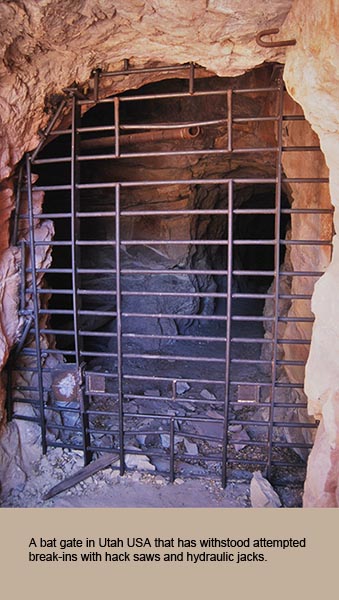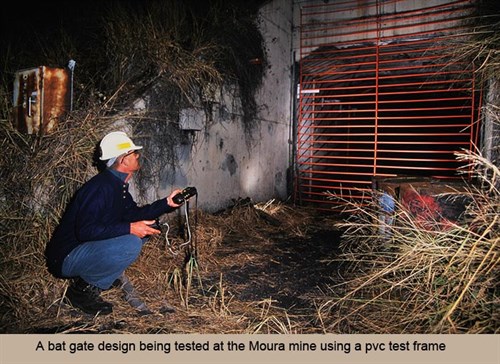Many abandoned and irregularly used mine sites provide excellent habitat for bats because of the creation of niche microclimates which are critical to their breeding success. Over time these old mines have become a significant tool in the conservation of bats and have prompted the develpment of bats and mines initiatives in Australia and across the World. RedLeaf's principal bat expert, Dr Bruce Thomson, is internationally recognised for his efforts in bat conservation and the mitigation of impacts on bats in mine sites. In the past, his work has taken him to the USA where he has studied the various 'bats and mines' management approaches being used by state mining and conservation groups in their abandoned mine lands projects, with support from Bat Conservation International. He has also undertaken field research in South America, the Sinai Peninsula in Egypt, Borneo and Sumatra.
In most cases where abandoned mines are occupied by bats and are available for protection, the primary focus is to keep people out and to make the area safe. This can be achieved through a number of means including fencing, removal of access tracks or gating of the mine entrance. Where mines cannot be saved and have to be destroyed, new cave habitats can be built to replace them.
As Dr Thomson relates, “In my experience, there are four important considerations when conserving bat habitats on mining precincts.”
The Design of Safety Gates, Barriers to Bats
Safety to the public is paramount to rehabilitation efforts. The gating of an entrance to a mine shaft sounds simple enough. In fact it is anything but, because bats see primarily with echolocation. They produce high frequency sound pulses and interpret the echoes to determine the location and size of obstacles (or possible food) in their flight path. So they see metal barred gates in a very different way to humans. A gate that appears to be quite well made to us, can be a barrier to bats. It requires specialist knowledge of the individual species and a thorough grounding in the physics of sound to build good bat gates. Dr Thomson has investigated many gates over the past few years and removed many of them, replacing them with species-specific gate designs that work.
 Air Flow Changes and effects on Microclimate
Air Flow Changes and effects on Microclimate
Bats almost always select their roost sites to take advantage of the specific temperature and humidity characteristics found in the site. Any gate that alters the air flow in a cave or mine can radically alter this microclimate and cause the bats to abandon the site. These gates have been incorrectly designed and installed requiring their complete redesign and installation at significant cost to the mining company to achieve high safety standards and bat conservation outcomes.
Human Proof Gates
The gate has to be ‘human-proof’. It seems that most fossickers view gates on mines as meaning only one thing – there must be gold and other priceless treasures hidden within! So therefore, the gate has to be breached at all costs! It is not easy building a gate that can withstand this type of attack. But Dr Thomson has experience in making gates bullet proof or at least tamper proof.
Artificial Cave Habitats, specialist design required. Not all caves and mines are suitable for bats!
New cave habitats can indeed be built to replace caves or old mines that are going to be destroyed. This can be a very effective strategy and provide cost savings. It can be done. But again, this activity is not for the non-specialist as the structure of the site and the creation of appropriate microclimates is critical to their success. Like storing vintage wines, bats require exact microclimates maintained in artificial cave habitats.
If you need to manage conservation outcomes for Australian bats as part of your project, you need a specialist. Dr Thomson is the only Australian bat specialist who has this type of expertise in mine site rehabilitation, gained through hands-on experience in the USA, where these techniques have been developed and perfected over many years. As a part of RedLeaf Environmental, Bruce can manage your risk and provide you with cost-effective strategies that will stand up to scientific scrutiny and meet or exceed the standards required by state or Commonwealth regulatory agencies.

 Air Flow Changes and effects on Microclimate
Air Flow Changes and effects on Microclimate

